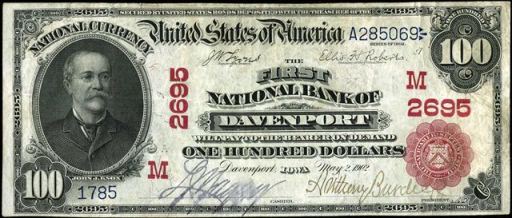The First National Bank Of Harrington
The First National Bank Of Harrington in Delaware printed $234,210 dollars worth of national currency. That is a small output. National bank notes from here should be scarce. This national bank opened in 1888 and stopped printing money in 1935, which equals a 48 year printing period. That is a fairly normal lifespan for a national bank. During its life, The First National Bank Of Harrington issued 8 different types and denominations of national currency. We have examples of the types listed below. Your bank note should look similar. Just the bank name will be different. For the record, The First National Bank Of Harrington was located in Kent County. It was assigned charter number 3883.
We buy all national currency. Please call or email us for a quote. Sales@AntiqueMoney.com
The First National Bank Of Harrington in Delaware printed 512 sheets of $50 1882 brown back national bank notes. Fifty dollar 1882 brown backs are few and far between. When the print number is under 1,000 like this bank then there is a great chance that you have a very rare bank note. The most common 1882 $50 brown backs are worth about $5,000. However, some can be worth more than $10,000 based on condition, serial number, and bank of issue.
Series of 1882 $50 Brown Back
The First National Bank Of Harrington printed 512 sheets of $100 1882 brown back national bank notes. High denomination $50 and $100 brown backs were printed on the same sheet. So the number of sheets printed also equals the number bills printed for each denomination. You can see that $100 brown backs are extremely scarce on this bank. We are very interested in purchasing $100 1882 brown back national bank notes. We have paid more than $15,000 for some examples. Send us pictures of what you have and we will respond quickly with an appraisal and offer.
Series of 1882 $100 Brown Back
The First National Bank Of Harrington also printed 60 sheets of $50 1902 red seal national bank notes. That is also the exact number of $50 red seals printed by this bank. Each sheet contained one $50 bill and one $100 bill. They are all extremely rare. The value for a generic circulated example is usually around $4,000. Most are worth more and some can be worth considerably more. John Sherman is pictured on each note. Otherwise it has the same markings you would expect to find on any 1902 red seal.
1902 $50 Red Seal National Bank Note
The First National Bank Of Harrington also printed 60 sheets of $100 1902 red seal national bank notes. As we said above, all high denomination 1902 red seals are extremely rare. The number of notes printed really doesn’t matter to collectors. 1902 $100 red seals are rare to the point that they are always in demand. Of course the standard valuation rules still apply. Condition and bank of issue are of paramount importance. We have paid over $12,000 for some of the rarest specimens.
1902 $100 Red Seal National Bank Note
The First National Bank Of Harrington also printed 300 sheets of $50 1902 blue seal national bank notes. There is no trick to knowing which 1902 blue seals will be common and rare. Often times the number printed won’t tell you much information. The value still comes down to condition and demand. That is a surprise to most people. In fact, most 1902 $50 bills we see are worth between $750 and $1,250. The rarer ones can be worth more than $5,000. However, there isn’t much middle ground.
1902 $50 Blue Seal National Bank Note
The First National Bank Of Harrington also printed 300 sheets of $100 1902 blue seal national bank notes. It is no coincidence that the sheet numbers for $50 bills and $100 bills are the same. They were printed on the same sheets. Most $100 blue seals are at least scarce; others can be very rare. John J Knox is printed on the front of each bill. Most collectors like the back design a lot more though. It is really unique and different from most other national bank notes. Prices for 1902 $100 blue seals are pretty similar to $50 blue seals. They are both equally common or equally rare, depending on how you look at it.
1902 $100 Blue Seal National Bank Note
The First National Bank Of Harrington also printed 584 sheets of Type1 1929 $10 national bank notes. This is a small print range, but it does not guarantee rarity. Each $10 bill from 1929 has a portrait of Alexander Hamilton on it. The black number written vertically is the charter number. The charter number never affects the value; it is just an identifier. The ten dollar type1 national bank note happens to be the single most common national bank note, with over 65,000 known to exist from all banks. Of course each note is valued based on its condition and rarity. Some are very rare.
Series of 1929 Type1 $10 National Bank Note
The First National Bank Of Harrington also printed 1,012 individual notes from the type2 1929 $10 national bank note series. That may seem like a high number, but remember that is total notes printed for the denomination, not sheets printed. The easiest way to spot the difference between type1 1929 $10 bills and 1929 type2 $10 bills is in the serial number. Type2 notes have a serial number that ends with a number. 1929 type1 notes have a serial number that ends with the letter A. Generally speaking, these $10 bills are rarer than the earlier type1 issues. However, most collectors don’t pay more for that rarity because they look basically the same.
Series of 1929 Type2 $10 National Bank Note



